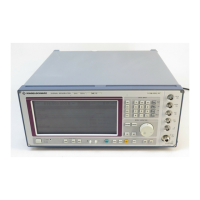Digital Modulation SME
1038.6002.02 2.116 E-13
2.6.3.13 Radiocommunication Service ReFLEX25
When equipped with the SME-B43, SME-B11 and SME-B12 options, the SME generates telegrams
complying to the ReFLEX25 standard. The telegram generated by the SME complies with the
ReFLEX25 Protocol Specification Document Version 2.4 dated March 15, 1996, issued by the Motorola
Advanced Messaging Group.
Notes:
-
When ReFLEX25 is switched on, all other DM modulations are automatically switched off.
-
To permit easier handling, a few settings are automatically updated each time ReFLEX25 is
switched on (and RECALCULATE executed) if other settings have been changed. This applies to
the RF frequency and the FRAME CONTENTS value. Normally, automatic mode is activated, but it
can be deactivated under AUTO ADAPTATION. Parameters that have been set automatically can
be varied again at will; these modifications take effect immediately.
- Fixed values
The following values in the telegram are fixed and cannot be changed:
- Base frame management (see 3.7.6.10 of the ReFLEX25 documentation): pf = 0, pn = 3,
ps = 0, cn = 2, cs = 3, pc = 5
- ALOHA Time-out and randomization interval (3.7.6.20): ri = 0, t = 0, LT = 0, rt = 0
- Message sequence number (3.9): msn = 32
- Vector format (3.10): last word only present if response required = 1. Values: rs = 0, rt = 0,
rc = 0, MR = 0; additionally for forward channel scheduling: fc = 0, ff = 0
- Priority bit in address field is always 0, i.e. only
one
tone-only call.
- Using the user-definable custom frames CUS1to CUS9
The SME permits to output user-definable frames. These frames must be generated on a host
processor (e.g. a PC) and transferred to the SME via IEC bus or RS232. The detailed procedure
will be described below in the section “Reading out, Modifying, Returning of Telegram Parts“,
reading out being omitted, of course, if the custom frames are completely generated on the host
processor.
The custom frames must have the following data format: Each transmitted symbol of a 4FSK
consists of an x and a y bit. X and y bits are filed in two separate byte arrays. The two arrays are
transferred to the SME separately. Each byte of the two arrays contains 8 valid x or y bits, which
permits to implement a 6400 bps-4FSK. In order to achieve a 2FSK all y bits must be set to 0. In
order to obtain lower bit rates, the bits must be doubled accordingly. The SME starts the
transmission with the MSB of the byte at the lowest address and stops with the LSB of the byte at
the highest address.

